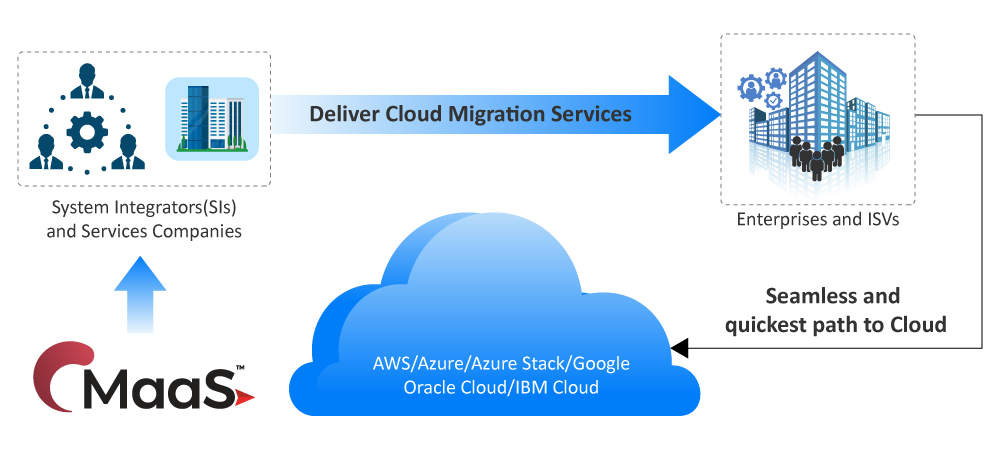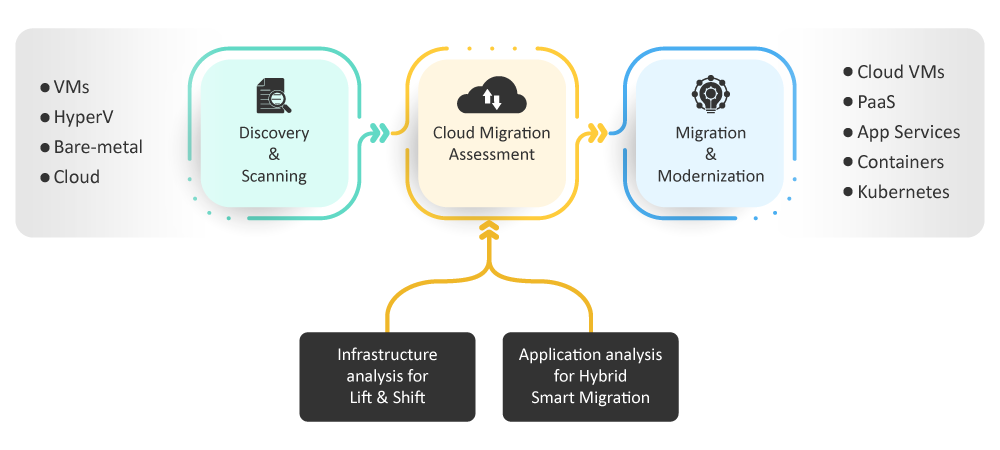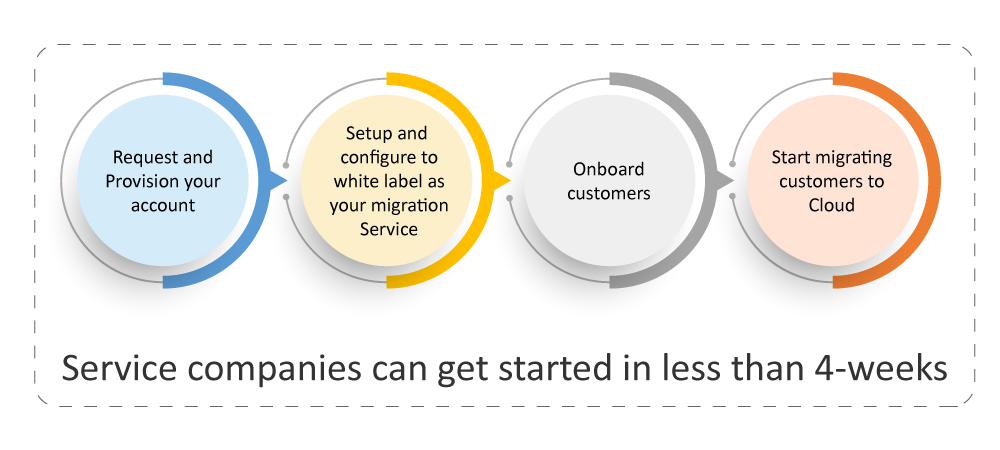Cloud adoption has been on an uptick these past few years, and various estimates suggest that the growth will be sustainable. And with good reasons, too. Cloud is a great enabler in that it democratizes technology by offering scalable resources to companies on budget and enabling large corporations to optimize their operations seamlessly. However, the chasm between the tech know-how required and the actual expertise within an enterprise often inhibits Cloud adoption.
This gap opens the possibility of a sustained and additional revenue stream for System Integrators (SIs). But can service providers offer a simple and robust solution, requiring little upfront capital investment, and yet proves to be cost-effective and efficient in the long run?

Corent’s MaaS offers service providers a zero-prep, zero-effort, and fully automated solution. They can white label Corent’s MaaS as a SaaS to analyze and shift their customer applications in hours while keeping the data secure (encryption) and highly available with zero downtime.
Service providers can now offer Cloud Migration service almost immediately by leveraging Corent’s Migration as a Service platform (MaaS). This platform can be setup in a matter of days and the Services team can be trained within a week to get started on their migration projects.
Complexity of assessment
Migration entails shifting the datacenter capabilities of an organization from on-premises to Cloud or from Cloud-to-Cloud. It requires a threadbare assessment of the infrastructure to identify the suitable workloads for transition. However, assessment is a pain point for many organizations as it is labor-intensive and time-consuming. The presence of several moving parts – starting from servers, IP addresses, and dependencies to workloads primed for migration – adds a layer of complexity to the process.
MaaS addresses the pain points by automating the arduous assessment process using an eclectic mix of methodologies to perform ‘as-is’ (lift and shift) migration or offer actionable recommendations to re-architect workloads to make them Cloud compatible (SmartShift).

We have seen enterprises moving beyond Lift’n’shift and requesting services to make their applications on the Cloud more efficient for cost and performance. Using smarter forms of migration brings these benefits by re-deploying the applications to a more effective topology for better management of workloads, moving to Containers and Kubernetes services for scaling and leveraging PaaS Services for redundancy.
Migration prerequisites
Analysis-paralysis is a genuine concern while planning migration; one scarcely knows where to draw the line between planning and too much planning. The roadmap to migration mandates a review of the customer’s objectives and the expected outcomes (business readiness); taking on board all stakeholders, defining and affixing roles and responsibilities (cultural readiness); aligning aspirations with real-world progress by assessing the inventory, and staggering transition (technical readiness).
MaaS aligns objectives with readiness to conduct a detailed assessment of the environment and issue migration recommendations. Service providers can use MaaS’ toolkit of industry-coveted solutions to automate transition. Here’s how:
1. MaaS Assess
MaaS Assess is a feasibility assessment tool that uses an in-built network discovery feature to scan the datacenter rapidly. It replaces error-prone human involvement to identify the servers and conduct a cloud compatibility analysis in a short time.
- Identifies workloads across VMs
- Requires only controller credentials to scan and conduct Move Group Analysis for dependency mapping
- Identifies the scope for optimization through Smart Scanner to offer actionable, smart re-architecture suggestions
- Helps applications achieve a variance of scalable, performable, backup-enabled, highly available, clustered for high reliability, and cost-effective topologies
- Integrates with asset management tools, such as Lansweeper and Movere, to rapidly chart out a migration strategy and identify Cloud readiness
2. MaaS Migrate
MaaS Migrate offers the broadest range of robust Cloud migration methodologies based on your business needs and the complexity of your environment.
- Migrates multiple servers in parallel coupled with clear, actionable reporting
- Offers zero-loss, secure migration through lift and shift
- Allows customization of automated migration plan using Smart Migration’s built-in scripting capability
- Deploys application over hybrid Cloud based on the business needs
- Helps orchestrate Cloud best practices and seamless migration
3. MaaS PaaSify
MaaS PaaSify is the only Cloud migration platform that lets you migrate any application and its databases to required PaaS services on Cloud with a single click.
- Helps build a complete dependency map of your application. Combine the map with our Move Group Analysis to prioritize an effective PaaS integration
- Identifies compatible PaaS services for your workloads and databases using MaaS Smart Advisories
- Allows for a cost comparison of different PaaS services across multiple Clouds
- Zero downtime migration to different PaaS services, like DBaaS and App PaaS Services
- Offers custom domain and load balancing while helping deploy applications as a fully managed platform by selecting appropriate App PaaS Services
4. MaaS Containerize
MaaS Containerize is the first-in-industry solution that fully automates containerization to offer businesses the benefits of Cloud without guzzling resources.
- Migrate existing containers available in your application rapidly by mapping relevant container services on Cloud
- Convert your workloads into Kubernetes Container Services, such as OpenShift, AKS, EKS, and GKE on Cloud
- Migrate application data to containers as separate disks to avoid data loss during provisioning. Enable end-to-end synchronization of data from the local environment to containers securely, with zero data loss or downtime
- Encapsulate DevOps and CI/CD capabilities into your application workload containers using MaaS for end-to-end management of your containers on the Cloud
By white labeling MaaS, service providers can use these tools in conjunction or in isolation to securely deliver migration solutions. This enables service providers to:
- Increase Cloud adoption and revenue
- Gain an additional revenue stream
- Avoid lengthy preparation and effort investment
- Save on technical resources
- Dominate their domain
MaaS as SaaS in four steps
Service providers searching for a robust solution can migrate their customer applications to the Cloud using MaaS in four simple steps:

- Provision account
- White label MaaS and set up customer subscription plans
- Onboard customers for application analysis
- Migrate customers’ apps to Cloud
Get in touch with Corent to see how our solutions can pave the path for your sustainable and sustained growth.

Edited By Shafi Syed. June 26, 2022

